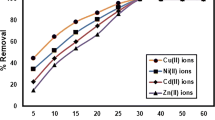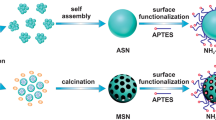Abstract
In this study, silica nanospheres (S) and trizma base-modified silica nanospheres (ST2, ST4, ST6, and ST8) were synthesized for the removal of arsenic from aqueous medium with high efficiency. Characterization of the prepared solid adsorbents was performed with different techniques such as thermogravimetric analysis, scanning electron microscopy, X-ray diffraction patterns, transmission electron microscopy, selected area electron diffraction, fast Fourier transform, nitrogen adsorption, point of zero charge (pHPZC), and Fourier transform infrared. Adsorption of As+5 was investigated under different application conditions such as adsorbent dosage, pH, shaking time, temperature, and initial As+5 concentration. Maximum adsorption capacity reached 64.5 mg g−1 at pH 6, 0.9 g L−1 as adsorbent dosage, after 60 min of shaking time, and at 25 °C as the optimum adsorption conditions. Adsorption data of As+5 by the prepared nanoadsorbents are best fitted with Langmuir, Temkin, and Dubinin–Radushkevich models. Kinetic studies revealed that the adsorption followed pseudo-second-order and Elovich kinetic models. Thermodynamic studies prove that the adsorption process is endothermic, spontaneous, and chemisorption in nature. The most effective desorption was achieved by nitric acid with 99% desorption efficiency. The prepared silica nanospheres solid adsorbents showed a good reusability with 91% adsorption efficiency after four cycles of adsorption and desorption.






Similar content being viewed by others
References
Abdel-Fattah, T.M.; Mahmoud, M.E.: Selective extraction of toxic heavy metal oxyanions and cations by a novel silica gel phase functionalized by vitamin B4. Chem. Eng. J. 172, 177–183 (2011)
Vega, M.P.B.; Hinojosa-Reyes, M.; Hernández-Ramírez, A.; Guzmán Mar, J.L.; Rodríguez-González, V.; Hinojosa-Reyes, L.: Visible light photocatalytic activity of sol–gel Ni-doped TiO2 on p-arsanilic acid degradation. J. Sol-Gel. Sci. Technol. 85, 723–731 (2018)
Huang, Y.; Yang, Y.; Hu, H.; Xu, M.; Liu, H.; Li, X.; Wang, X.; Yao, H.: A deep insight into arsenic adsorption over γ-Al2O3 in the presence of SO2 /NO. Proc. Combust. Inst. 37, 2951–2957 (2019)
Sherlala, A.I.A.; Raman, A.A.A.; Bello, M.M.; Buthiyappan, A.: Adsorption of arsenic using chitosan magnetic graphene oxide nanocomposite. J. Environ. Manag. 246, 547–556 (2019)
Li, Z.; Liu, X.; Jin, W.; Hu, Q.; Zhao, Y.: Adsorption behavior of arsenicals on MIL-101(Fe): the role of arsenic chemical structures. J. Colloid Interface Sci. 554, 692–704 (2019)
Mohammed, T.; Kazeem, T.S.; Essa, M.H.; Labaran, B.A.; Vohra, M.S.: Comparative study on electrochemical treatment of arsenite: effects of process parameters, sludge characterization and kinetics. Arab. J. Sci. Eng. 45, 3799–3815 (2020)
An, B.; Steinwinder, T.R.; Zhao, D.: Selective removal of arsenate from drinking water using a polymeric ligand exchanger. Water Res. 39, 4993–5004 (2005)
Luo, M.K.; Lin, H.; He, Y.H.; Li, B.; Dong, Y.B.; Wang, L.: Efficient simultaneous removal of cadmium and arsenic in aqueous solution by titanium-modified ultrasonic biochar. Bioresour. Technol. 284, 333–339 (2019)
Da Silva, E.B.; de Oliveira, L.M.; Wilkie, A.C.; Liu, Y.; Ma, L.Q.: Arsenic removal from As-hyperaccumulator Pteris vittata biomass: coupling extraction with precipitation. Chemosphere 193, 288–294 (2018)
Yue, T.; Niub, Z.; Hu, Y.; Han, H.; Sun, W.; Tian, J.; Xu, Z.; Wang, L.; Yang, Y.: Arsenic adsorption on ferric oxyhydroxide gel at high alkalinity for securely recycling of arsenic-bearing copper slag. Appl. Surf. Sci. 478, 213–222 (2019)
Leslie, L.A.T.; María, M.B.: Predicting the adsorption capacity of iron nanoparticles with metallic impurities (Cu, Ni and Pd) for arsenic removal: a DFT study. Adsorption 26, 127–139 (2020)
Hashim, M.A.; Kundu, A.; Mukherjee, S.; Ng, Y.; Mukhopadhyay, S.; Redzwan, G.; Gupta, B.S.: Arsenic removal by adsorption on activated carbon in a rotating packed bed. J. Water Process Eng. 30, 100591–100560 (2019)
Hu, C.; Chen, Q.; Li, H.; Qu, J.: Coagulation of methylated arsenic from drinking water: influence of methyl substitution. J. Hazard. Mater. 293, 97–104 (2015)
Zhang, A.; Huang, N.; Zhang, C.; Zhao, P.; Lin, T.; He, Y.: Heterogeneous Fenton decontamination of organoarsenicals and simultaneous adsorption of released arsenic with reduced secondary pollution. Chem. Eng. J. 344, 1–11 (2018)
Sandhi, A.; Landberg, T.; Greger, M.: Phytofiltration of arsenic by aquatic moss (Warnstorfia fluitans). Environ. Pollut. 237, 1098–1105 (2018)
Alakhras, F.; Ouerfelli, N.; Al-Mazaideh, G.; Ababneh, T.; Al-Abbad, E.; Abouzeid, F.: Optimal pseudo-average order kinetic model for correlating the removal of nickel ions by adsorption on nanobentonite. Arab. J. Sci. Eng. 44, 159–168 (2019)
Duran, H.; Alkan, F.Ü.; Ulkay, M.B.; Karakuş, S.; Aktş, A.; Şişmanoğlu, T.: Investigation of the in vitro cytotoxic effects and wound healing activity of ternary composite substance (hollow silica sphere/gum arabic/methylene blue). Int. J. Biol. Macromol. 121, 1194–1202 (2019)
Ruffel, L.; Soulié, J.; Coppel, Y.; Roblin, P.; Brouillet, F.; Tourbin, M.: Ibuprofen loading into mesoporous silica nanoparticles using Co-Spray drying: a multi-scale study. Microporous Mesoporous Mater. 291, 109689–109699 (2020)
Wang, X.; Zhao, Z.: Spherical hollow mesoporous silica supported phosphotungstic acid as a promising catalyst for α-arylstyrenes synthesis via Friedel-Crafts alkenylation. Chin. Chem. Lett. 30(3), 729–734 (2019)
Shuangqing, S.; Xiyu, Z.; Meng, C.; Yan, W.; Chunling, L.; Songqing, H.: Facile preparation of redox-responsive hollow mesoporous silica spheres for the encapsulation and controlled release of corrosion inhibitors. Prog. Org. Coat. 136, 105302–105310 (2019)
Zong, J.; Zhang, Y.S.; Zhu, Y.; Zhao, Y.; Zhang, W.; Zhu, Z.: Rapid and highly selective detection of formaldehyde in food using quartz crystal microbalance sensors based on biomimetic poly-dopamine functionalized hollow mesoporous silica spheres. Sens. Actuators B. Chem. 271, 311–320 (2018)
Kalhor, M.M.; Rafati, A.A.; Rafati, L.: Synthesis, characterization and adsorption studies of amino functionalized silica nano hollow sphere as an efficient adsorbent for removal of imidacloprid pesticide. J. Mol. Liq. 266, 453–459 (2019)
Najafi, M.; Yousefi, Y.; Rafati, A.A.: Synthesis, characterization and adsorption studies of several heavy metal ions on amino-functionalized silica nano hollow sphere and silica gel. Sep. Purif. Technol. 85, 193–205 (2012)
Hassan, A.F.: Synthesis of carbon nano-onion embedded metal–organic frameworks as an efficient adsorbent for cadmium ions: kinetic and thermodynamic studies. Environ. Sci. Pollut. Res. 26(23), 24099–24111 (2019)
Langmuir, I.: The adsorption of gases on plane surfaces of glass, mica and platinum. J. A. Chem. Soc. 38, 2221–2295 (1916)
Hyun-Kyu, L.; Jung-Weon, C.; Sang-June, C.: Magnetic ion-imprinted polymer based on mesoporous silica for selective removal of Co (II) from radioactive wastewater. Sep. Sci. Technol. (2020). https://doi.org/10.1080/01496395.2020.1797798
Dada, A.O.; Olalekan, A.P.; Olatunya, A.M.: Langmuir, Freundlich, Temkin and Dubinin–Radushkevich isotherms studies of equilibrium sorption of Zn2+ unto phosphoric acid modified rice husk. J. Appl. Chem. 3(1), 38–45 (2012)
Banerjee, S.; Chattopadhyaya, M.C.: Adsorption characteristics for the removal of a toxic dye, tartrazine from aqueous solutions by a low-cost agricultural by-product. Arab. J. Chem. 10, S1629–S1638 (2017)
Hassan, A.F.; Elhadidy, H.: Production of activated carbons from waste carpets and its application in methylene blue adsorption: Kinetic and thermodynamic studies. J. Environ Chem. Eng. 5, 955–963 (2017)
Yuan, J.; Zhou, T.; Pu, H.: Nano-sized silica hollow spheres: Preparation, mechanism analysis and its water retention property. J. Phys. Chem. Solids. 71, 1013–1019 (2010)
Chitra, K.; Annadurai, G.: Fluorescent silica nanoparticles in the detection and control of the growth of pathogen. J. Nanotechnol. 7(17), 1–7 (2013)
Shitre, P.V.; Harale, R.R.; Sathe, B.R.; Shingare, M.M.S.: Silica nanosphere-graphene oxide (SiO2–GO) hybrid catalyzed facile synthesis of functionalized quinoxaline derivatives. Res. Chem. Intermed. 43, 829–841 (2017)
Gorji, B.; Ghasri, M.R.A.; Fazaeli, R.; Niksirat, N.: Synthesis and characterizations of silica nanoparticles by a new sol-gel method. J. Appl. Chem. Res. 6(3), 22–26 (2012)
Skwarek, E.; Goncharuk, O.; Sternik, D.; Janusz, W.; Gdula, K.; Gun’ko, V.M.: Synthesis, structural, and adsorption properties and thermal stability of nanohydroxyapatite/polysaccharide composites. Nanoscale Res. Lett. 12, 155–166 (2017)
Hassan, A.F.; Helmy, S.A.; Donia, A.: MCM-41 for meloxicam dissolution improvement: in vitro release and in vivo bioavailability studies. J. Brazil. Chem. Soc. 26(7), 1367–1378 (2015)
Zhang, Y.; Cao, X.; Sun, J.; Wu, G.; Wang, J.; Zhang, D.: Synthesis of pyridyl Schiff base functionalized SBA-15 mesoporous silica for the removal of Cu (II) and Pb (II) from aqueous solution. J. Solgel Sci. Technol. 94, 658–670 (2019)
Romero, A.A.; Alba, M.D.; Zhou, W.; Klinowski, J.: Synthesis and characterization of the mesoporous silicate molecular sieve MCM-48. J. Phys. Chem. 101, 5294–5300 (1997)
White, L.D.; Tripp, C.P.: Reaction of (3-Aminopropyl) dimethylethoxysilane with amine catalysts on silica surfaces. J. Colloid Interface Sci. 232, 400–407 (2000)
Chen, B.; Quan, G.; Wang, Z.; Chen, J.; Wu, L.; Xu, Y.; Li, G.; Wu, C.: Hollow mesoporous silica as a drug solution delivery system for insoluble drugs. Powder Technol. 240, 48–53 (2013)
Mahmoud, M.E.; Fekry, N.; El-Latif, M.M.A.: Nanocomposites of nanosilica-immobilized-nanopolyaniline and crosslinked nanopolyaniline for removal of heavy metals. Chem. Eng. J. 304, 679–691 (2016)
Su, H.; Ye, Z.; Hmidi, N.: High-performance iron oxide-graphene oxide nanocomposite adsorbents for arsenic removal. Colloids Surf. A Physicochem. Eng. Asp. 522, 161–172 (2017)
Escudero, C.; Fiol, N.; Villaescusa, I.; Bollinger, J.C.: Arsenic removal by a waste metal (hydr) oxide entrapped into calcium alginate beads. J. Hazard. Mater. 164, 533–541 (2009)
Wu, F.; Tseng, R.; Juang, R.: Characteristics of Elovich equation used for the analysis of adsorption kinetics in dye-chitosan systems. Chem. Eng. J. 150, 366–373 (2009)
Zhang, Y.; Jin, F.; Shen, Z.; Lynch, R.; Al-Tabbaa, A.: Kinetic and equilibrium modeling of MTBE (methyl tert-butyl ether) adsorption on ZSM-5 zeolite: batch and column studies. J. Hazard. Mater. 347, 461–469 (2018)
Erhayem, M.; Al-Tohami, F.; Mohamed, R.; Ahmida, K.: Isotherm, kinetic and thermodynamic studies for the sorption of mercury (II) onto activated carbon from rosmarinus officinalis leaves. Am. J. Anal. Chem. 6, 1–10 (2015)
Shahmohammadi, K.S.H.; Babazadeh, H.; Nazemi, A.H.; Manshouri, M.: Isotherm and kinetic studies on adsorption of Pb, Zn and Cu by Kaolinite. Casp. J. Environ. Sci. 9, 243–255 (2011)
Helfferich, F.: Ion Exchange. McGraw-Hill, New York (1962)
Bertolini, T.C.R.; Izidoro, J.C.; Magdalena, C.P.; Fungaro, D.A.: Adsorption of crystal violet dye from aqueous solution onto zeolites from coal fly and bottom ashes. Electron. J. Chem. 5(3), 179–191 (2013)
Agarwal, S.; Tyagi, I.T.; Gupta, V.K.; Ghasemi, N.; Shahivand, M.; Ghasemi, M.: Kinetics, equilibrium studies and thermodynamics of methylene blue adsorption on Ephedra strobilacea saw dust and modified using phosphoric acid and zinc chloride. J. Mol. Liq. 218, 208–218 (2016)
Bulánek, R.; Hrdina, R.; Hassan, A.F.: Preparation of polyvinylpyrrolidone modified nanomagnetite for degradation of nicotine by heterogeneous Fenton process. J. Environ. Chem. Eng. 7, 102988–102997 (2019)
Jian, M.; Liu, B.; Hang, Z.G.; Liu, R.; Zhang, X.: Adsorptive removal of arsenic from aqueous solution by zeolitic imidazolate framework-8 (ZIF-8) nanoparticles. Coll. Surf. A. 465, 67–76 (2015)
Malana, M.A.; Qureshi, R.B.; Ashiq, M.N.: Adsorption studies of arsenic on nano aluminum doped manganese copper ferrite polymer (MA, VA, AA) composite: kinetics and mechanism. Chem. Eng. J. 172, 721–727 (2011)
Martinson, C.; Reddy, K.: Adsorption of arsenic (III) and arsenic (V) by cupric oxide nanoparticles. J. Colloid Interface Sci. 336, 406–441 (2009)
Habuda-Stanić, M.; Nujić, M.: Arsenic removal by nanoparticles: a review. Environ. Sci. Pollut. Res. 22, 8094–8123 (2015)
Zhu, H.; Jia, Y.; Wu, X.; Wang, H.: Removal of arsenic from water by supported nano zero-valent iron on activated carbon. J. Hazard. Mater. 172(2–3), 1591–1596 (2009)
Luther, S.; Borgfeld, N.; Kim, J.; Parsons, J.G.: Removal of arsenic from aqueous solution: a study of the effects of pH and interfering ions using iron oxide nanomaterials. Microchem. J. 101, 30–36 (2012)
Acknowledgements
The authors acknowledge the research sector of Damanhour University, Damanhour, Egypt, for financial support.
Author information
Authors and Affiliations
Corresponding author
Ethics declarations
Conflict of interest
The authors declare that they have no conflict of interest.
Supplementary Information
Below is the link to the electronic supplementary material.
Rights and permissions
About this article
Cite this article
Hassan, A.F., Hrdina, R. Enhanced Removal of Arsenic from Aqueous Medium by Modified Silica Nanospheres: Kinetic and Thermodynamic Studies. Arab J Sci Eng 47, 281–293 (2022). https://doi.org/10.1007/s13369-021-05357-5
Received:
Accepted:
Published:
Issue Date:
DOI: https://doi.org/10.1007/s13369-021-05357-5




